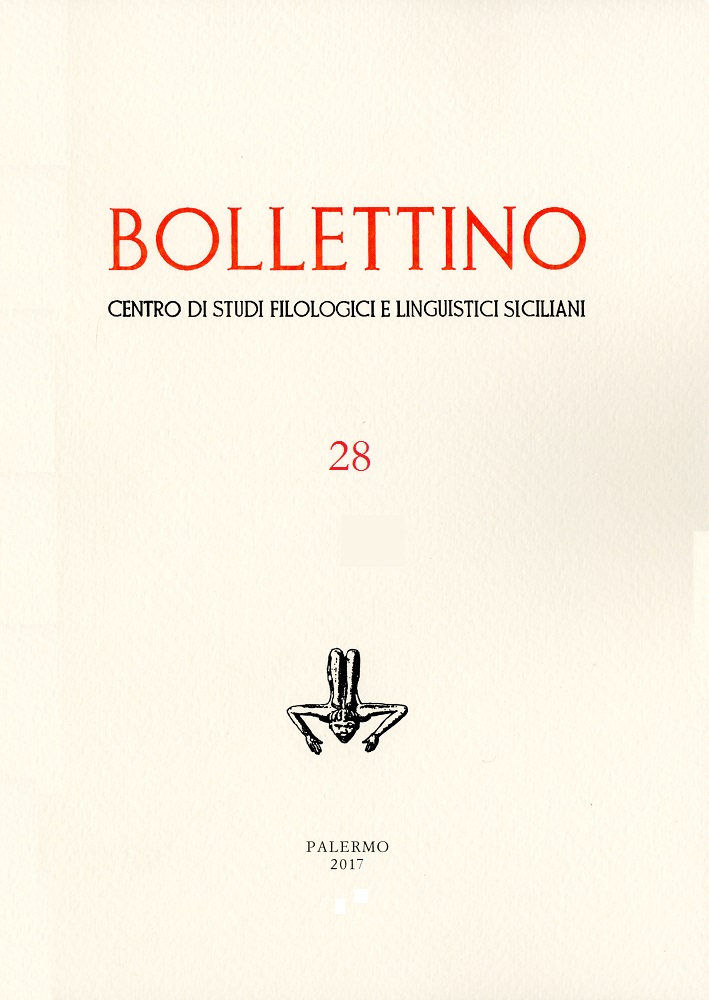| AUTORE | | ||
| TITOLO | | Bollettino n. 28 In ricordo di Tullio De Mauro |
|
| Curatore | | Franco Lo Piparo | |
| collana | | Bollettino CSFLS | |
| anno | pagine | ISSN | |
2017 292 0577-277X |
|
| prezzo | * disponibilità | |
€ 35,00 disponibile |
SOMMARIO
In ricordo di Tullio De Mauro
Franco Lo Piparo, A partire da Tullio De Mauro - I – PARLANTI E SCRIVENTI IN ITALIA - Luisa Amenta, Capire (e farsi capire) a scuola - Mari D’Agostino, Analfabeti nell’Italia di ieri e di oggi. Dati, modelli, persone, parole: la lezione di Tullio De Mauro - Claudio Marazzini, Dall’Italia unita all’Italia repubblicana: lezioni di stile e di metodo nella storia linguistica di Tullio De Mauro - Rosanna Sornicola, Il problema della storia linguistica: il contributo degli studi italiani degli anni Venti e Trenta del Novecento - II - IL LESSICO - Vincenzo Lo Cascio, Retorica e lessicografia. Il processo combinatorio - Salvatore Claudio Sgroi, Tullio De Mauro linguista-lessicografo - III – SIGNIFICARE E PARLARE - Francesco La Mantia, “Un atteggiamento irenico”. Su alcune pagine culioliane di Tullio De Mauro - Francesca Piazza, Le parole dell’odio. Dal lessico alle pratiche verbali - Patrizia Violi, Sul significare. De Mauro e Eco: due maestri di pensiero e di vita - IV – SAUSSURE E I PROBLEMI TEORICI DEL LINGUAGGIO - Felice Cimatti, Tullio De Mauro e la filosofia italiana del linguaggio - Giorgio Graffi, Saussure, De Mauro e Timpanaro - Antonino Pennisi, Cosa può un corpo. Spinoza e l’Embodied Cognition - Jürgen Trabant, Wilhelm von Humboldt a Roma: l’antichità e lo spirito della Nazione - Sebastiano Vecchio, Sulla distentio in sant’Agostino.
Riassunto/abstract
approfondimenti
Questo volume del Bollettino raccoglie 15 contributi pensati a partire dall’opera di Tullio De Mauro. Apre la raccolta il saggio introduttivo di Franco Lo Piparo (pp. 5-13) che contestualizza la figura e il pensiero di De Mauro mostrandone i legami con Pagliaro, Wittgenstein e Gramsci. Gli altri contributi sono suddivisi in quattro sezioni che riflettono i temi di ricerca di De Mauro. La prima sezione (Parlanti e scriventi in Italia) include i saggi di Luisa Amenta (pp. 17-34) sul tema della comprensione linguistica nella scuola, quello di Mari D’agostino (pp. 35-58) sull’analfabetismo in Italia, quello di Claudio Marazzini (pp. 59-66) dedicato alla Storia linguistica dell’Italia repubblicana come prosecuzione ideale della Storia linguistica dell’Italia unita e quello di Rosanna Sornicola (pp- 67-82) dedicato al contributo degli studi italiani degli anni Venti e Trenta del secolo scorso alla storia della linguistica. La seconda sezione (Il lessico) include i saggi di Vincenzo Lo Cascio (pp. 85-108) sul processo combinatorio delle lingue tra retorica e lessicografia e quello di Salvatore Claudio Sgroi (pp. 109-148) sulla produzione lessicografica di De Mauro. La terza sezione (Significare e Parlare) raccoglie i contribuiti di Francesco La Mantia (pp. 151-174) sulla presenza della riflessione linguistica di Antoine Culioli nel pensiero di De Mauro, di Francesca Piazza (pp.175-190) sul fenomeno della violenza verbale, di Patrizia Violi (pp. 191-194) sulle figure di Eco e De Mauro come maestri. La quarta sezione (Saussure e i problemi teorici del linguaggio) raccoglie i saggi di Felice Cimatti (pp. 199-214) su De Mauro e la filosofia italiana del linguaggio, quello di Giorgio Graffi (pp. 215-236) sui rapporti tra Saussure, De Mauro e Timpanaro, quello di Antonino Pennisi (pp. 237-264) sul tema dell’embodiement cognition messo in relazione con il pensiero di Spinoza, quello di Jürgen Trabant (pp. 265-280) sulla lingua come “spirito della nazione” in Humbolt e, infine, quello di Sebastiano Vecchio (pp. 281-287) sul rapporto tra lingua e temporalità affrontato attraverso la nozione agostiniana di distentio.
This issue of the Bollettino gathers 15 texts based on the works of Tullio De Mauro. In the introductory essay, Franco Lo Piparo (pp. 5-13) contextualizes the role and the thought of De Mauro, showing the connections to Pagliaro, Wittgenstein and Gramsci. The other texts are divided into four sections which correspond to De Mauro's main research topics. The first section (Parlanti e scriventi in Italia) includes the texts of Luisa Amenta (pp. 17-34) on linguistic comprehension at school, Mari D'Agostino (pp.35-58) on illiteracy in Italy, Claudio Marazzini (pp. 59-66) on the Storia linguistica dell'Italia repubblicana considered as an ideal continuation of the Storia linguistica dell'Italia unita, and that of Rosanna Sornicola (pp. 67-82) on the contribution of the Italian 1920s and 1930s thought to the history of linguistics. The second section (Il lessico) gathers the texts of Vincenzo Lo Cascio (pp. 85-108) on the combinatorial process of languages, between rhetoric and lexicography, as well as that of Salvatore Claudio Sgroi (pp. 109-148) on De Mauro's lexicographical writings. The third section (Significare e Parlare) includes the texts of Francesco La Mantia (pp. 151-174) on the presence of Antoine Culioli's linguistic reflection in the working of De Mauro, that of Francesca Piazza (pp.175-190) on the phenomenon of verbal violence, followed by those of Patrizia Violi (pp. 191-194) on the figures of Eco and De Mauro as masters of arts. The fourth section (Saussure e I problem teorici del linguaggio) gathers essays by Felice Cimatti (pp. 199-214) on De Mauro and the Italian philosophy of language, that written by Giorgio Graffi (pp. 215-236) on the relations between Saussure, De Mauro and Timpanaro, and that by Antonino Pennisi (pp. 237-264) on the embodiment cognition in its relation to Spinoza's thought, followed by the text of Jürgen Trabant (pp. 265-280) on language as "the spirit of the nation" in Humbolt and, last but not least, an essay by Sebastiano Vecchio (pp. 281-287) on the relation between language and temporality as filtered by the Augustinian notion of distentio.


